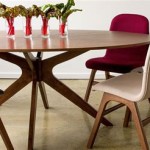Kitchen Table Solutions for Studio Apartments: Maximizing Space and Functionality
Studio apartments present unique spatial challenges. The integration of living, sleeping, and dining areas within a single, often limited, space requires careful planning and strategic furniture selection. The kitchen table, in particular, becomes a multifunctional piece that must serve as a dining surface, workspace, and potentially even a storage solution. Choosing the right kitchen table for a studio apartment is therefore critical to maximizing functionality and creating a comfortable, livable environment.
This article explores various kitchen table options tailored for studio apartments, focusing on design considerations, space-saving features, and material choices that contribute to an efficient and aesthetically pleasing living space. Practical solutions and considerations will be presented to guide individuals in selecting a kitchen table that effectively addresses the demands of compact living.
Understanding Space Constraints and Multifunctionality
The primary consideration when selecting a kitchen table for a studio apartment is the limited space available. Traditional, large dining tables are generally unsuitable. Instead, smaller, more adaptable tables are essential. These tables should ideally be versatile and capable of serving multiple purposes. Consider the dimensions of the available space carefully. Measure the area where the table will be placed, accounting for clearance around the table for chairs and movement. This will help determine the maximum acceptable size of the table.
Multifunctionality is key. The kitchen table in a studio apartment is rarely used solely for dining. It often serves as a workspace for home office tasks, a surface for hobbies and projects, or even an extension of the kitchen countertop for food preparation. Tables with features that support these multiple uses are particularly valuable. For instance, a table with built-in storage, such as drawers or shelves, can help declutter the living space by providing a place to store items like office supplies, books, or kitchen utensils.
Drop-leaf tables are an excellent example of space-saving, multifunctional furniture. These tables have hinged leaves that can be folded down when not in use, reducing the table's footprint. When needed for dining or other activities, the leaves can be extended to provide a larger surface area. Similarly, tables with a folding mechanism can be completely collapsed and stored away when not required, freeing up floor space for other activities.
Another important aspect of multifunctionality is the table's height. While standard dining tables are typically around 30 inches high, a taller table, such as a counter-height or bar-height table, can serve as a workspace or a casual dining area. Counter-height tables are often paired with stools, which can be easily tucked away under the table when not in use, further saving space. Consider how the table will primarily be used and choose a height that is comfortable and functional for the intended activities.
Exploring Different Table Styles and Designs
The style and design of the kitchen table should complement the overall aesthetic of the studio apartment. A cohesive design helps create a sense of unity and order within the limited space. Consider the existing furniture and décor when selecting a table style. Minimalist designs are often a good choice for studio apartments, as they tend to be simple, clean, and uncluttered. These designs typically feature straight lines, neutral colors, and minimal ornamentation, which helps to create a sense of spaciousness.
Round tables can be particularly effective in small spaces. Unlike rectangular tables, which can block pathways and create a sense of confinement, round tables encourage conversation and allow for easier movement around the room. A round table also eliminates sharp corners, making it a safer option, especially in apartments with young children. When selecting a round table, consider the diameter carefully to ensure that it provides enough surface area for dining or other activities without overwhelming the space.
Square tables offer a balance between the space-saving benefits of round tables and the functionality of rectangular tables. A small square table can comfortably accommodate two people for dining or working. When more space is needed, it can be easily pushed against a wall to create a larger work surface or dining area. Square tables are also well-suited for creating a cozy breakfast nook in a corner of the apartment.
Consider glass-top tables. The transparent nature of glass creates a sense of openness and airiness, making the space feel larger. Glass-top tables also allow light to pass through, which can brighten up the room. However, glass tables may require more frequent cleaning to maintain their appearance. The base of a glass-top table can be made of metal, wood, or other materials, allowing for customization to match the overall décor of the apartment.
Nesting tables offer extreme versatility. A set of nesting tables consists of two or more tables of different sizes that can be stacked together when not in use. When needed, the tables can be pulled out and used as individual dining surfaces, side tables, or workspaces. Nesting tables are particularly useful for accommodating guests or for creating flexible arrangements in a studio apartment.
Material Considerations and Durability
The choice of materials for the kitchen table significantly impacts its durability, aesthetics, and ease of maintenance. Wood tables are a classic choice, offering warmth, character, and durability. Solid wood tables are particularly sturdy and can last for many years with proper care. However, solid wood tables can be relatively expensive and may require regular maintenance, such as oiling or polishing. Wood veneer tables offer a more affordable alternative while still providing the look and feel of real wood. Veneer tables consist of a thin layer of wood applied to a composite core, such as particleboard or MDF (medium-density fiberboard). These tables are generally less expensive than solid wood tables but may not be as durable.
Metal tables are another durable and stylish option. Metal tables are often used in contemporary or industrial-style interiors. They are typically easy to clean and maintain and can withstand heavy use. Metal tables can be made of steel, iron, aluminum, or other metals. Steel tables are particularly strong and can support heavy loads. Aluminum tables are lightweight and rust-resistant, making them a good choice for humid environments.
Laminate tables offer a budget-friendly and low-maintenance option. Laminate is a synthetic material that is applied to a composite core. Laminate tables are typically resistant to scratches, stains, and heat, making them ideal for everyday use. They are also easy to clean with a damp cloth. Laminate tables are available in a wide range of colors and patterns, allowing for customization to match the décor of the apartment.
Consider the finish of the table. A durable finish is essential for protecting the table from scratches, stains, and water damage. Polyurethane is a common finish that provides a hard, protective layer. It is available in various sheens, from matte to glossy. Oil-based finishes penetrate the wood and provide a natural look and feel. Oil-based finishes require regular maintenance to prevent drying and cracking. Wax finishes offer a soft, lustrous sheen but are less durable than polyurethane or oil-based finishes. The legs and frame of the table also contribute to its overall durability. Ensure that the legs are sturdy and well-attached to the tabletop. Look for tables with reinforced legs or a solid base to ensure stability.
Finally, consider the environmental impact of the materials used in the table. Look for tables made from sustainably sourced wood or recycled materials. Choosing eco-friendly furniture helps reduce your environmental footprint and supports responsible manufacturing practices.
By carefully considering the space constraints, exploring different table styles and designs, and evaluating material considerations, individuals can select a kitchen table that effectively maximizes functionality and enhances the livability of their studio apartment. The kitchen table, when chosen thoughtfully, serves as a central hub for various activities, contributing significantly to the overall comfort and efficiency of the living space.

10 Space Saving Dining Tables For Your Tiny Apartment

Shopping For Compact Dining Tables The New York Times

48 Brilliant Small Apartment Ideas For Space Saving Matchness Com

How To Fit A Dining Table In Small Space Hollyburn Properties

A Studio Apartment With Tall Beige Kitchen Coco Lapine Designcoco Design

Dining Table Set Kitchen For 4 Rectangular Room With 2 Benches Small Space Apartment Retro Brown
Nordic Dining Table Small Apartment Modern Simple Solid Wood Legs Round Living Room Household And Chair

15 Functional And Cozy Scandinavian Interior Design Ideas

Space Saving Dining Table Expand Furniture

25 Tiny Apartment Dining Rooms That Save Space And Multitask Decoist








